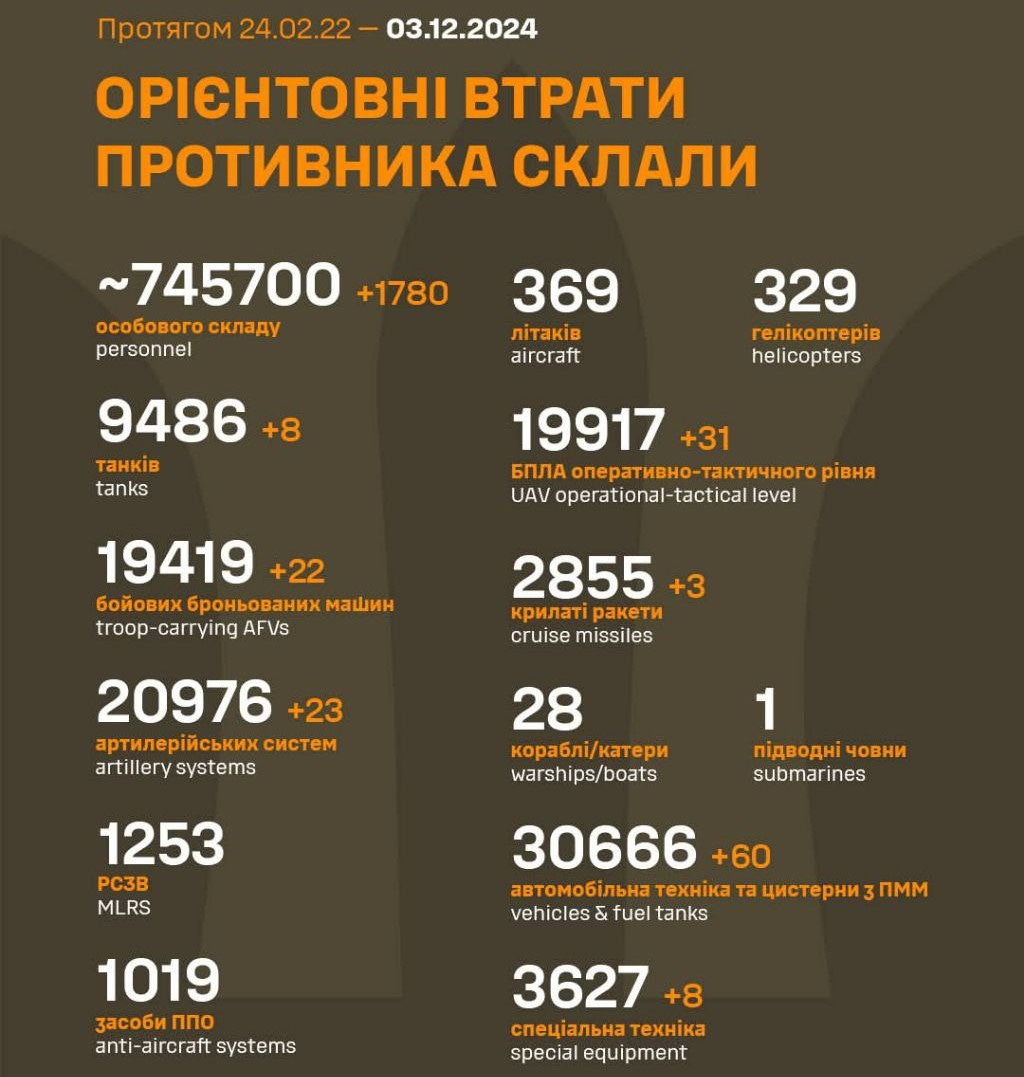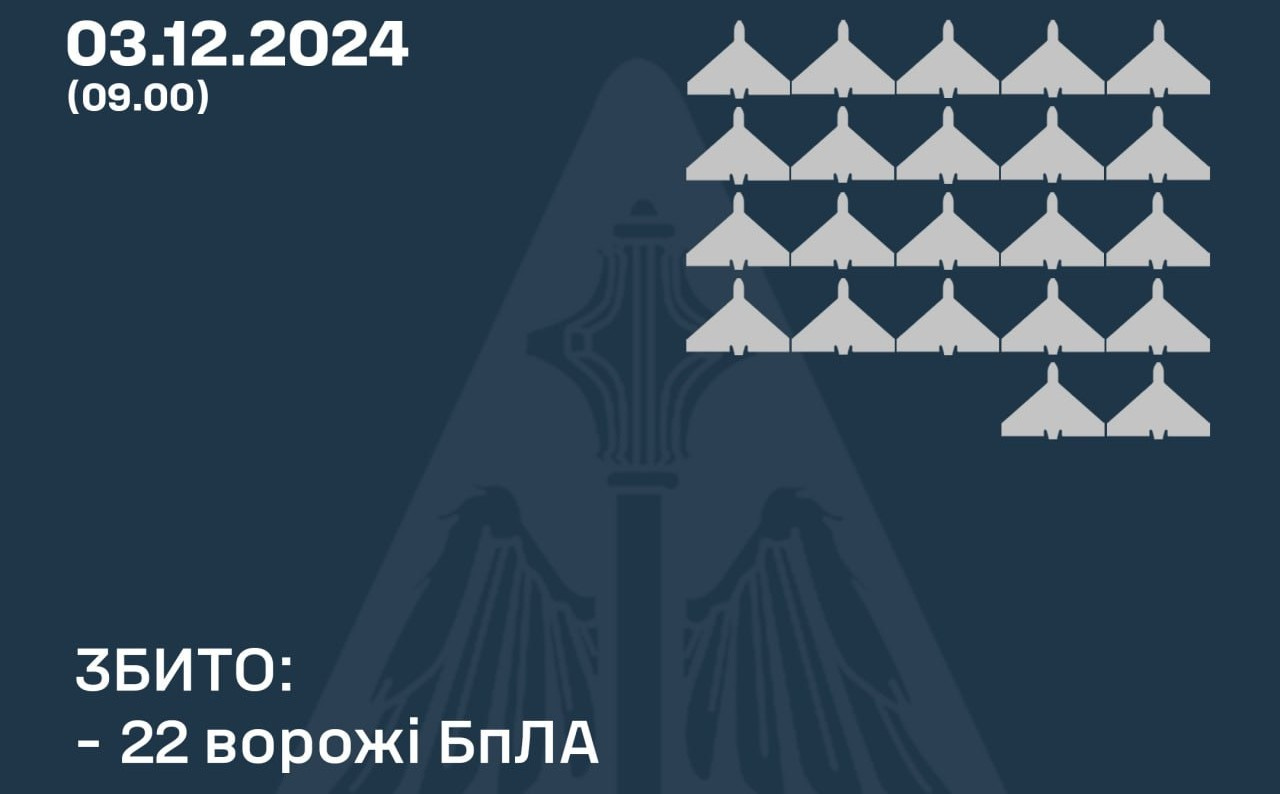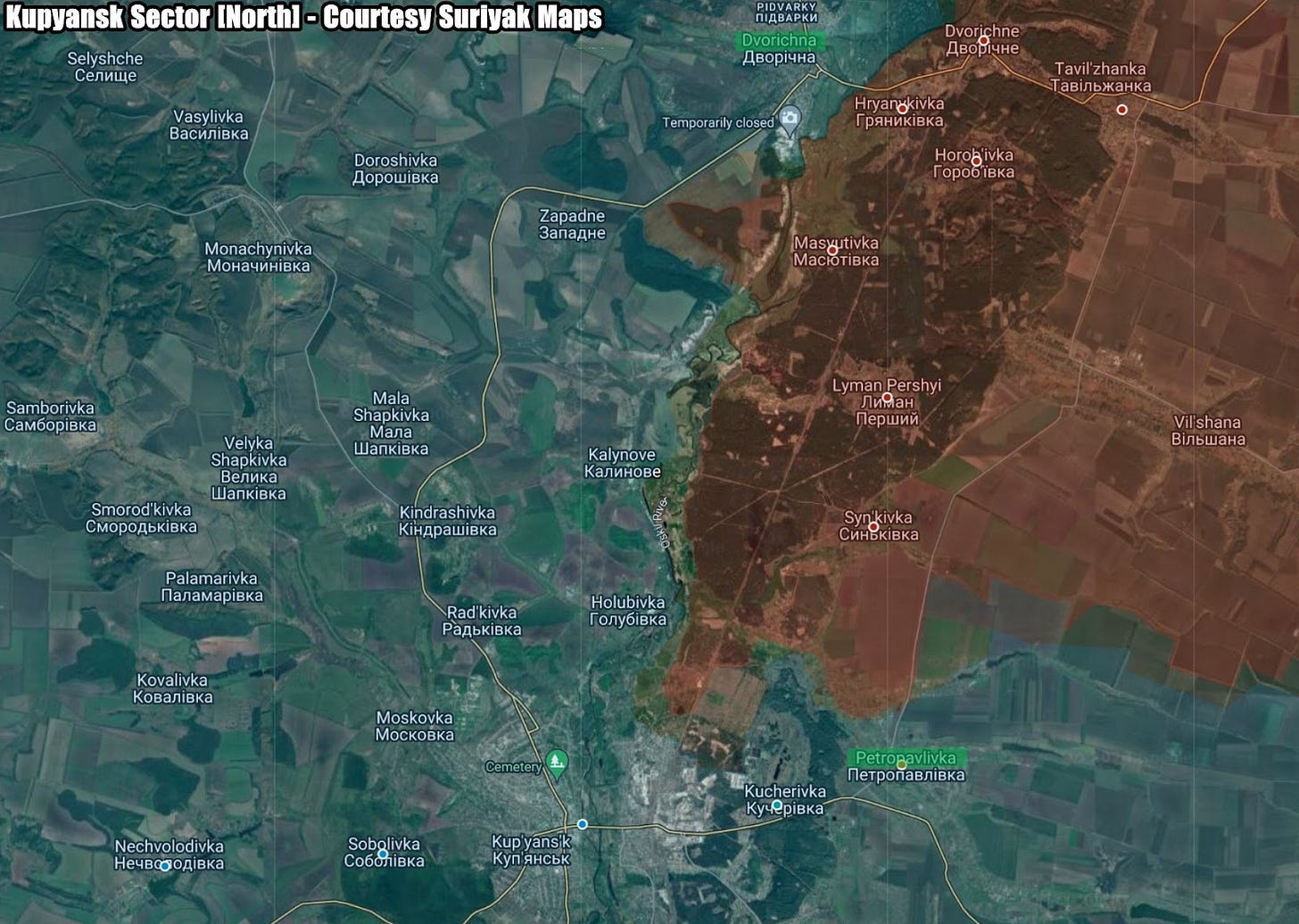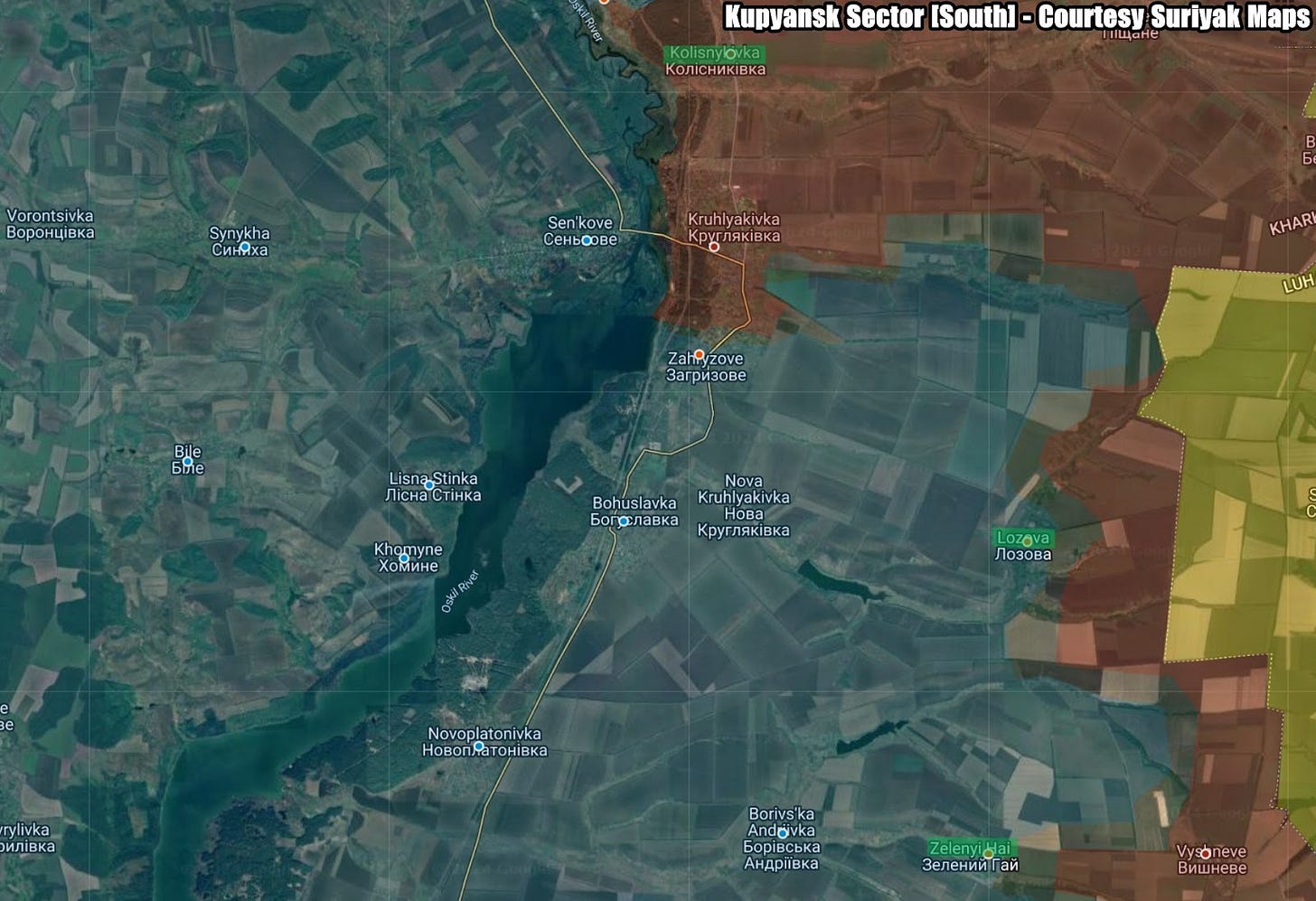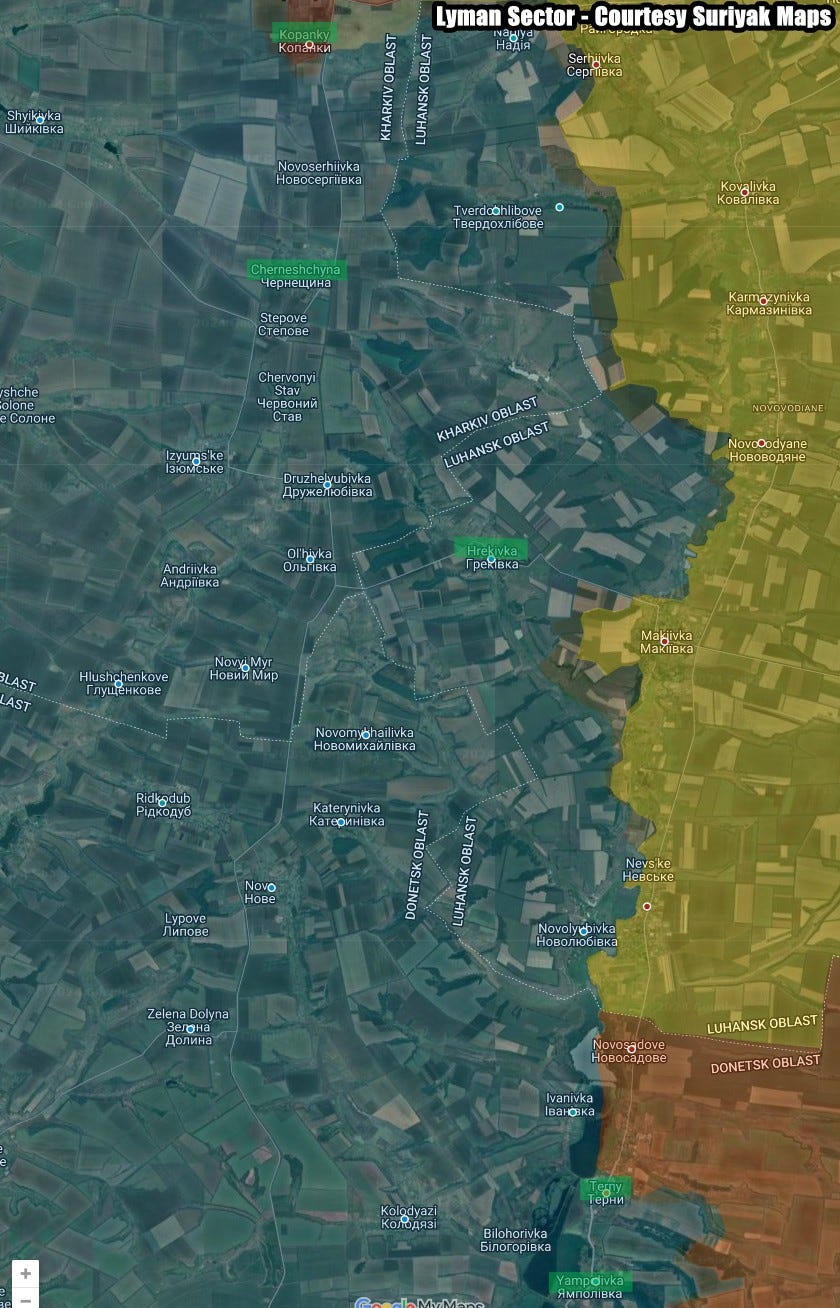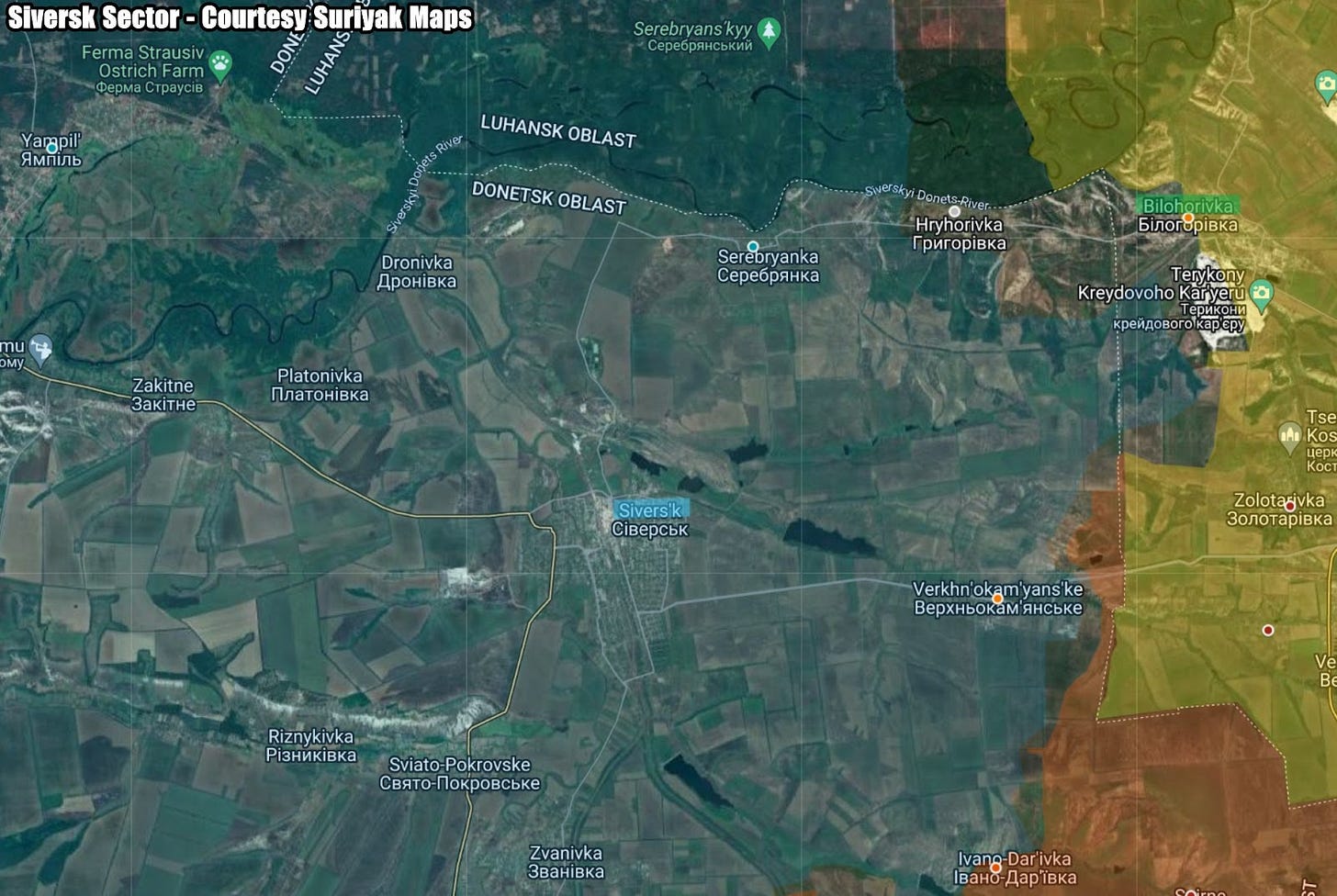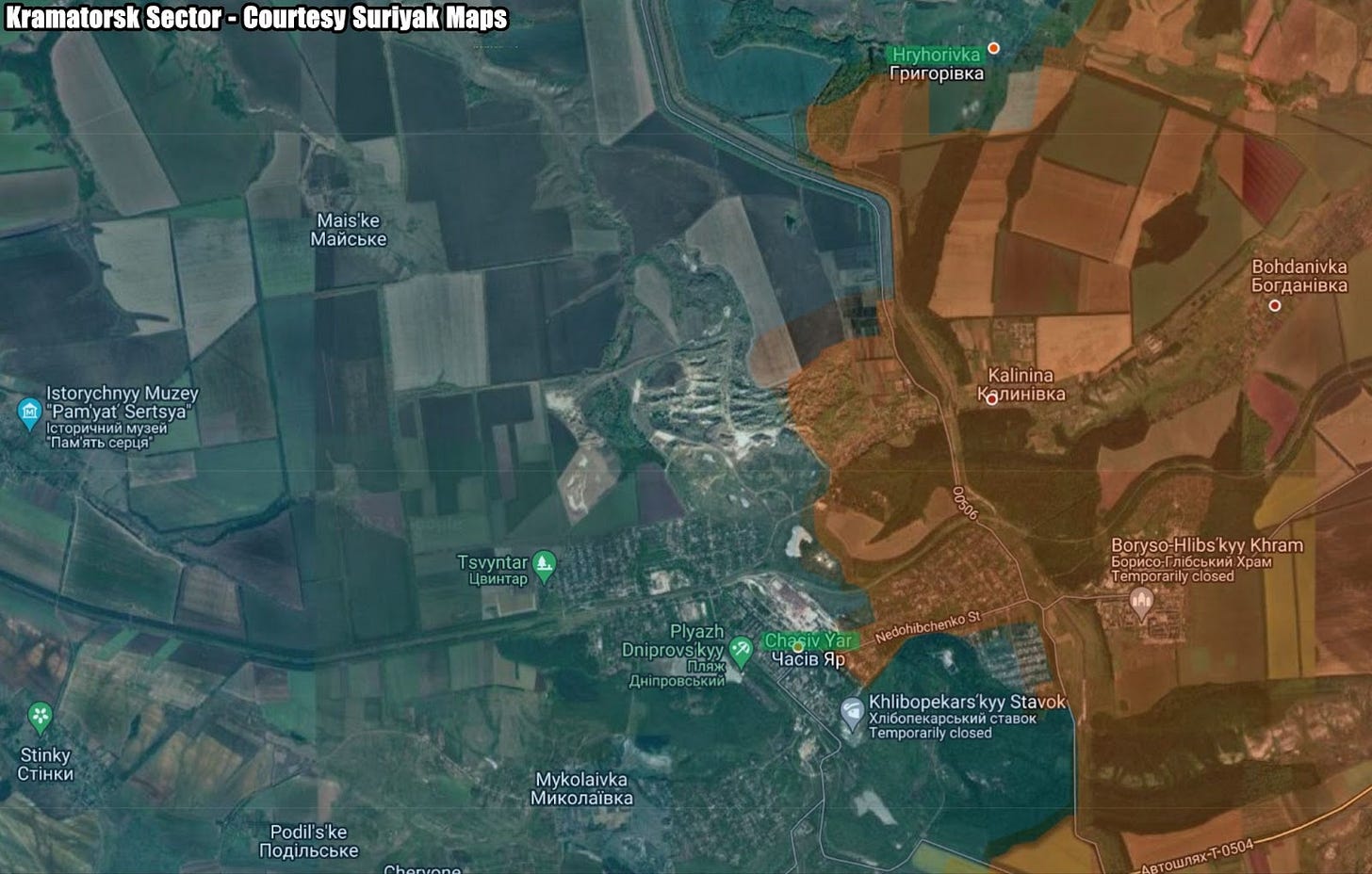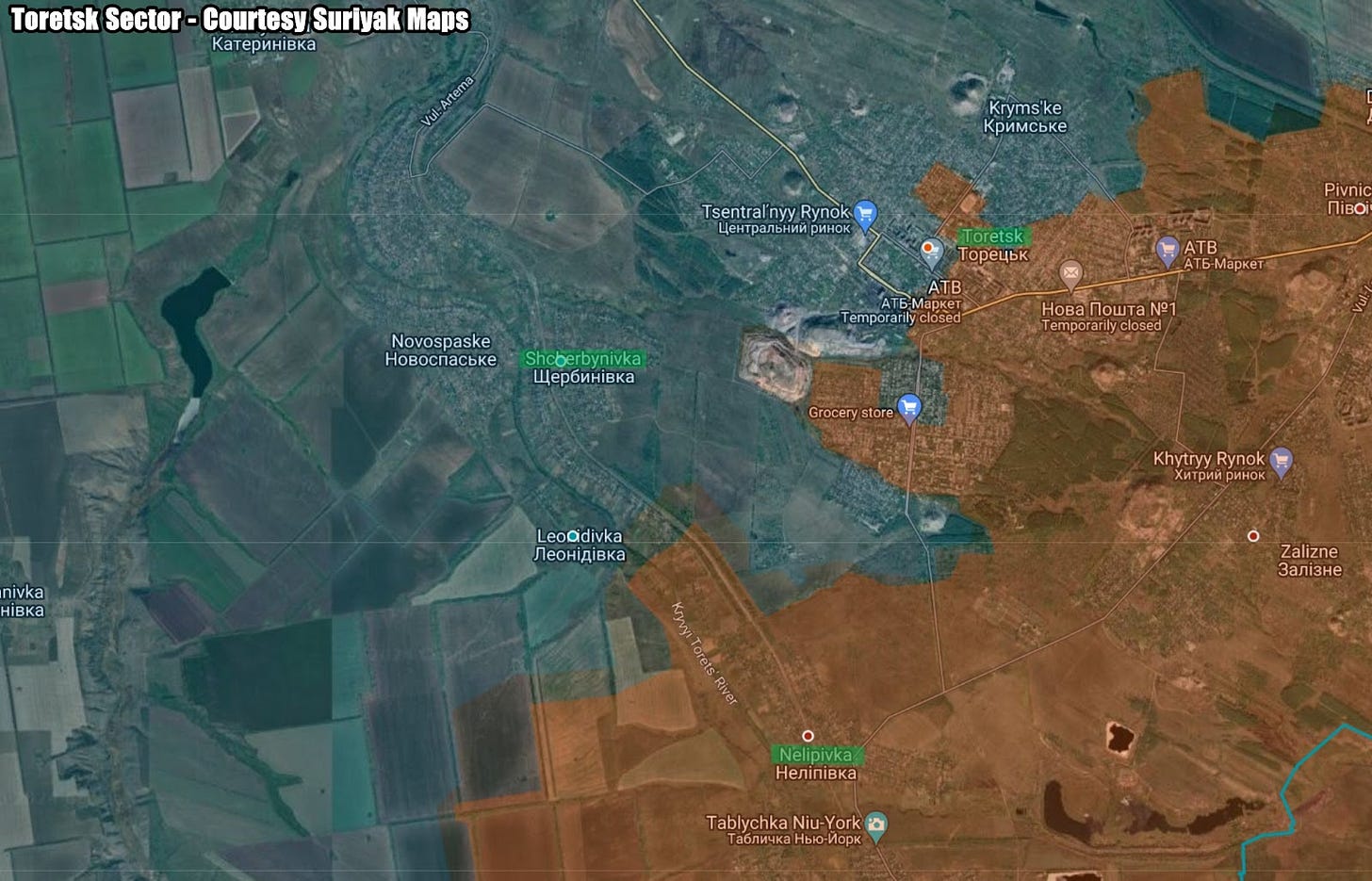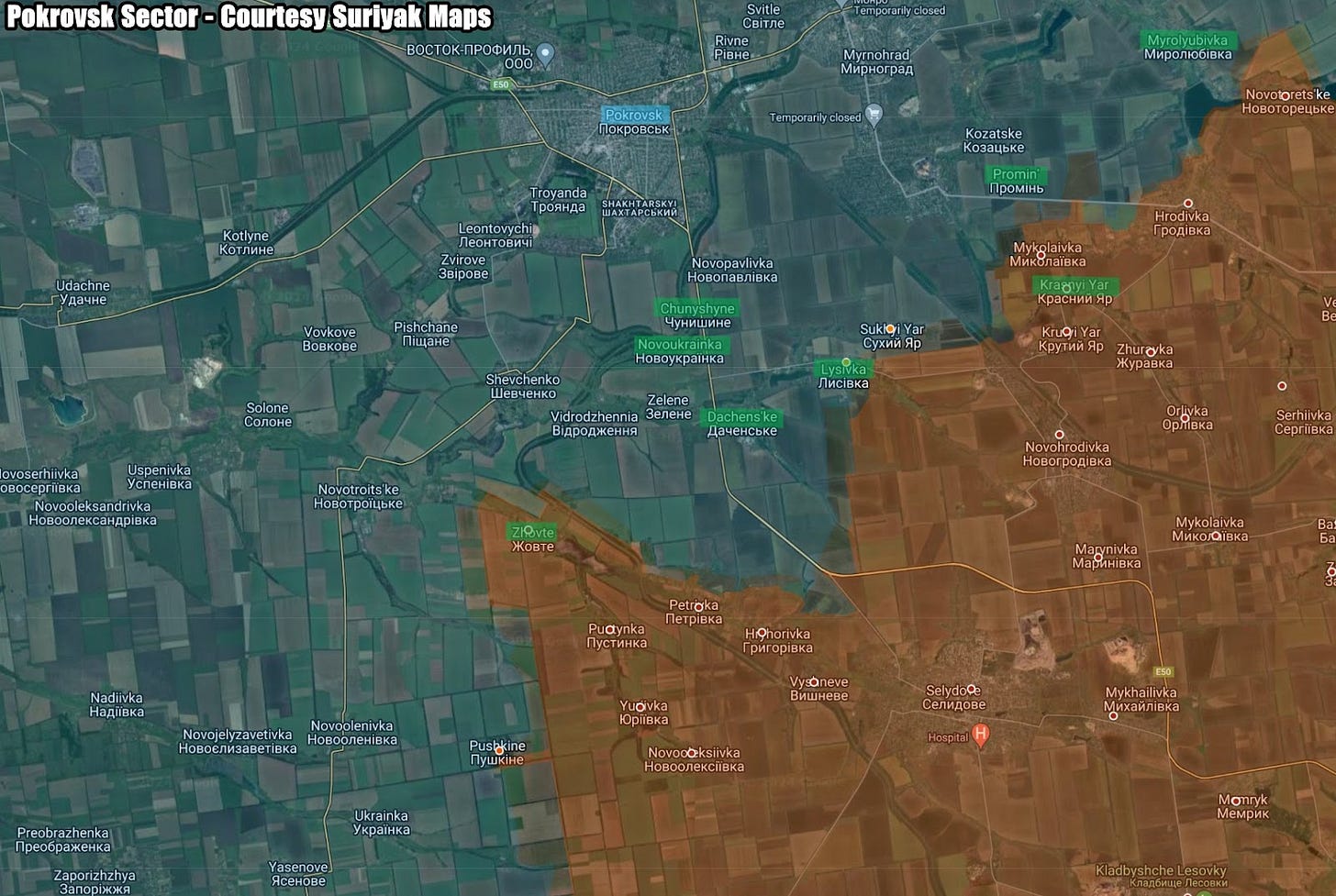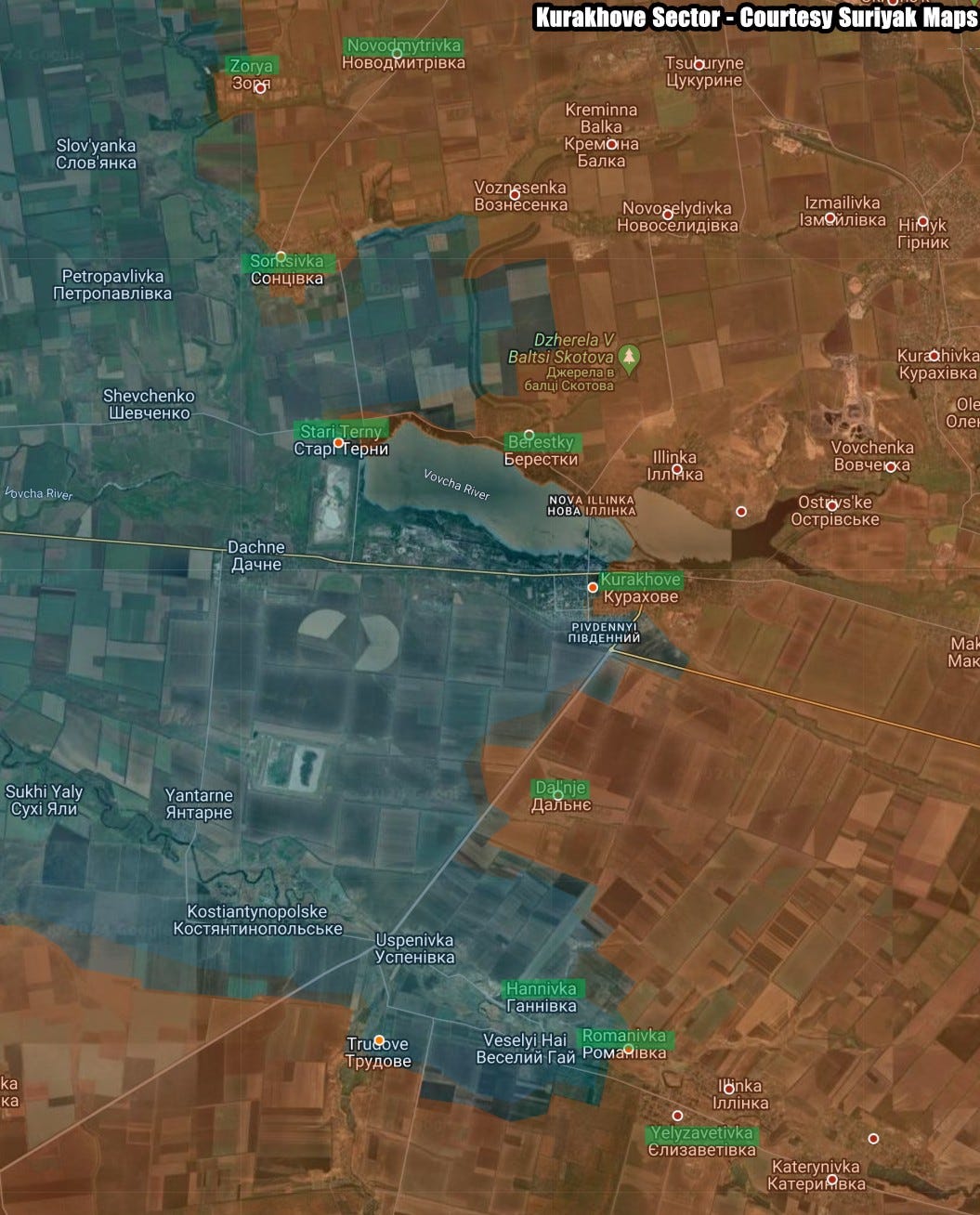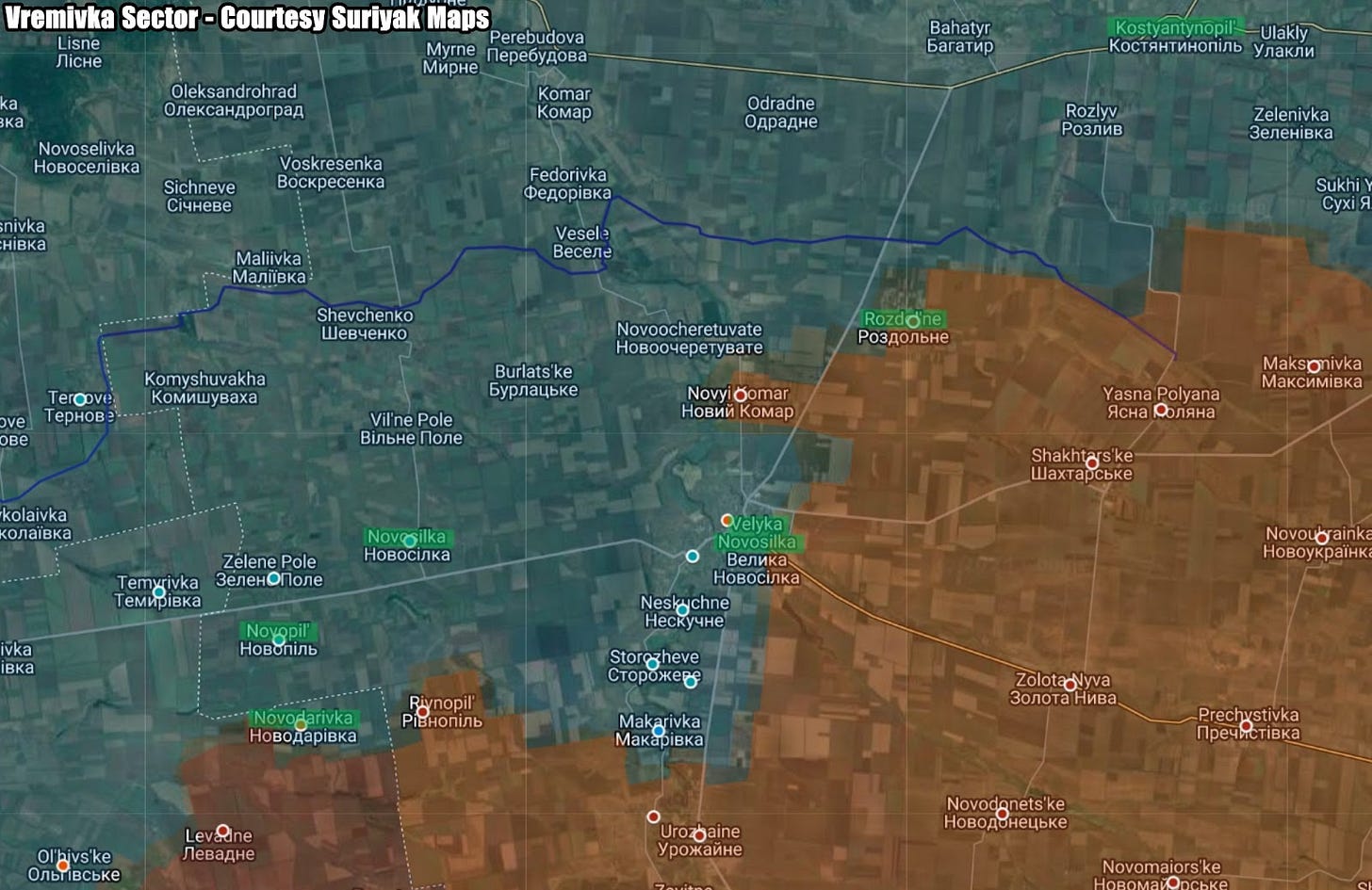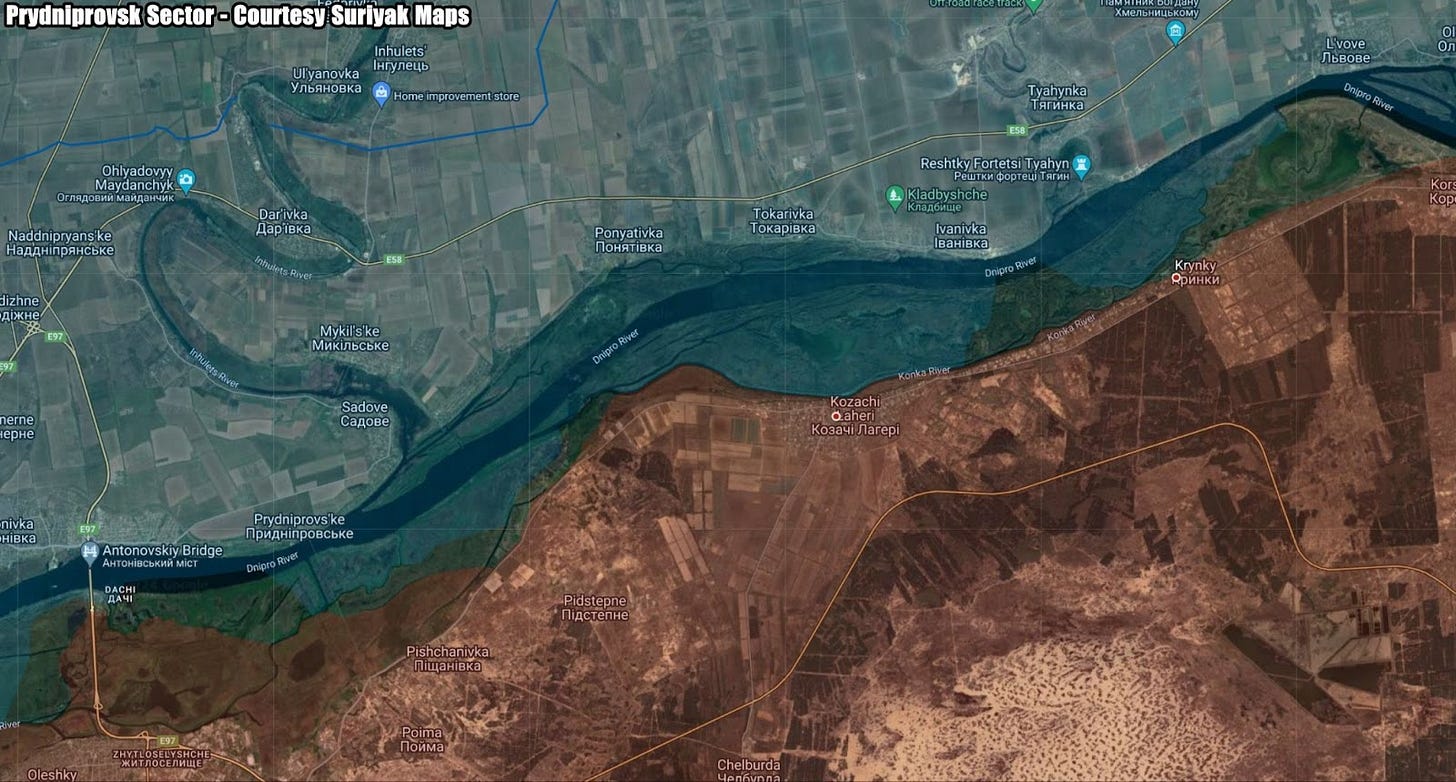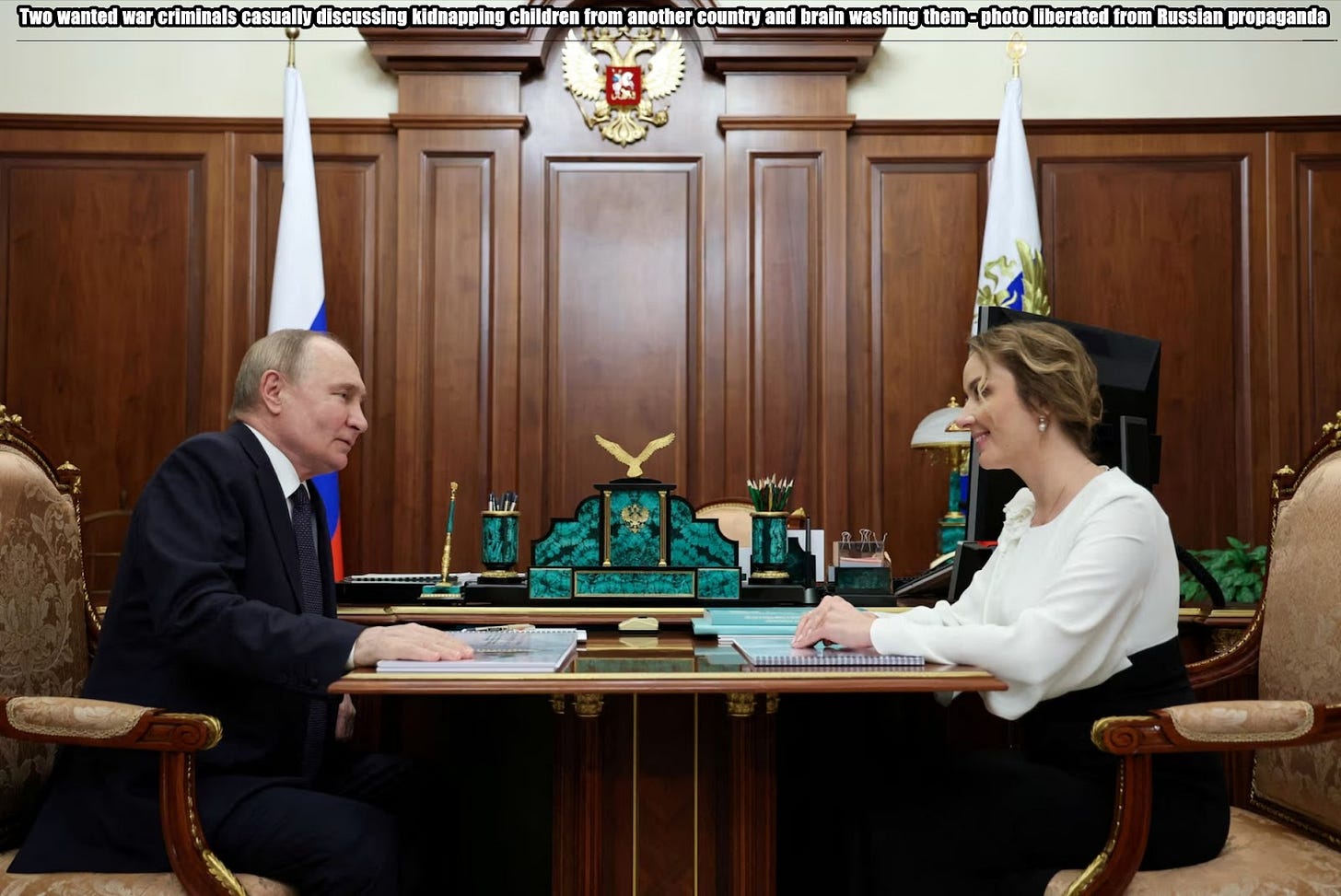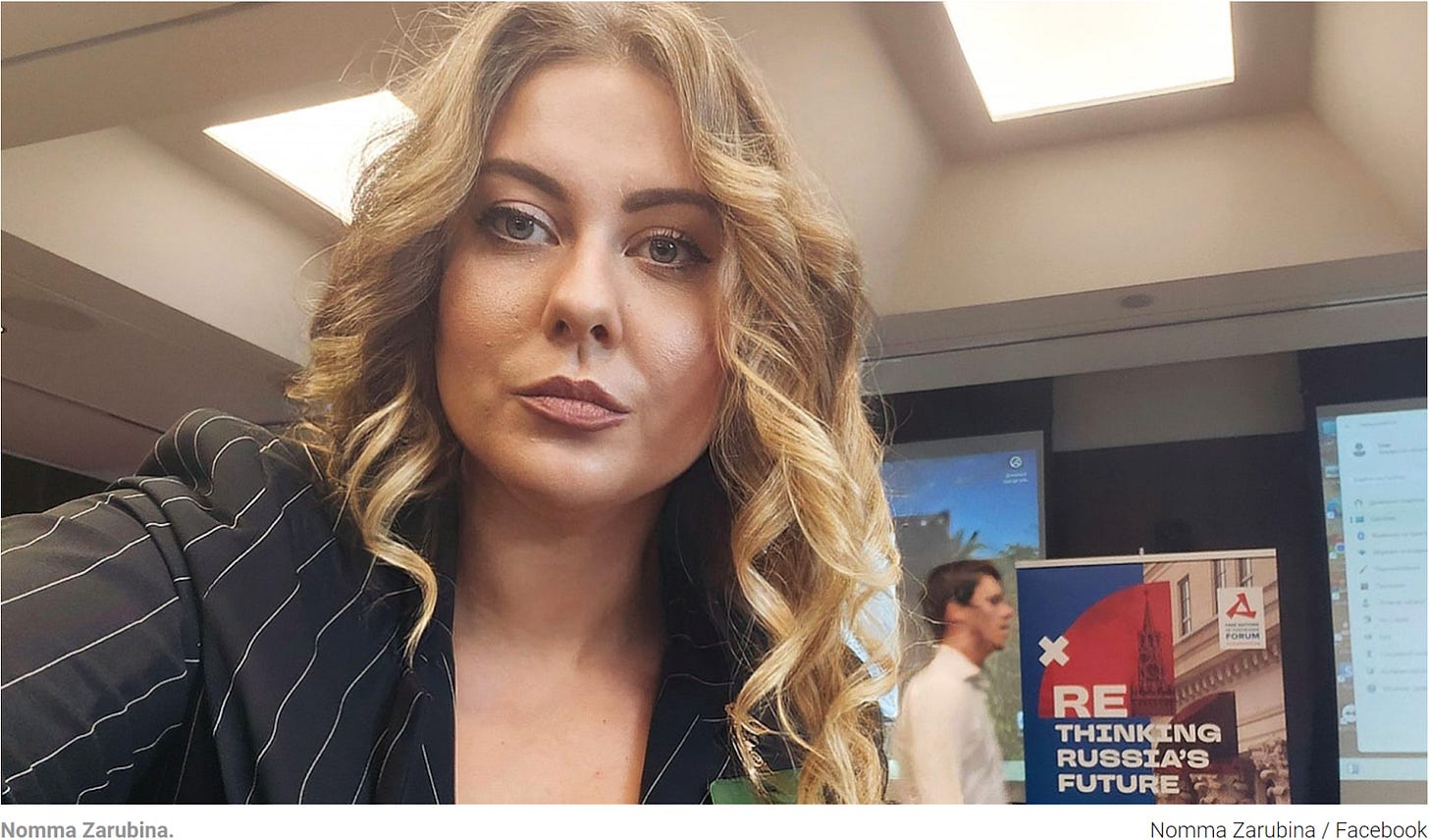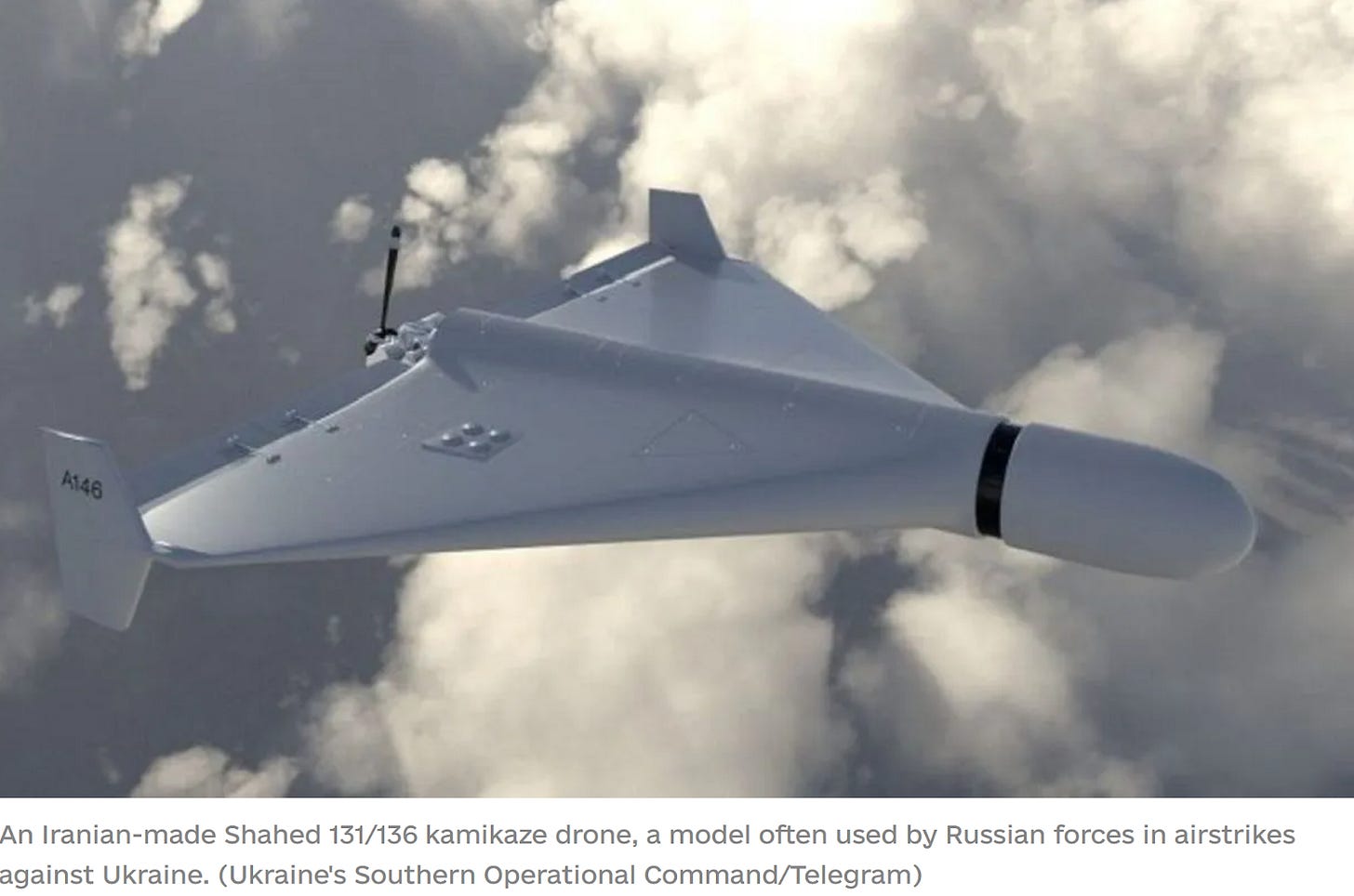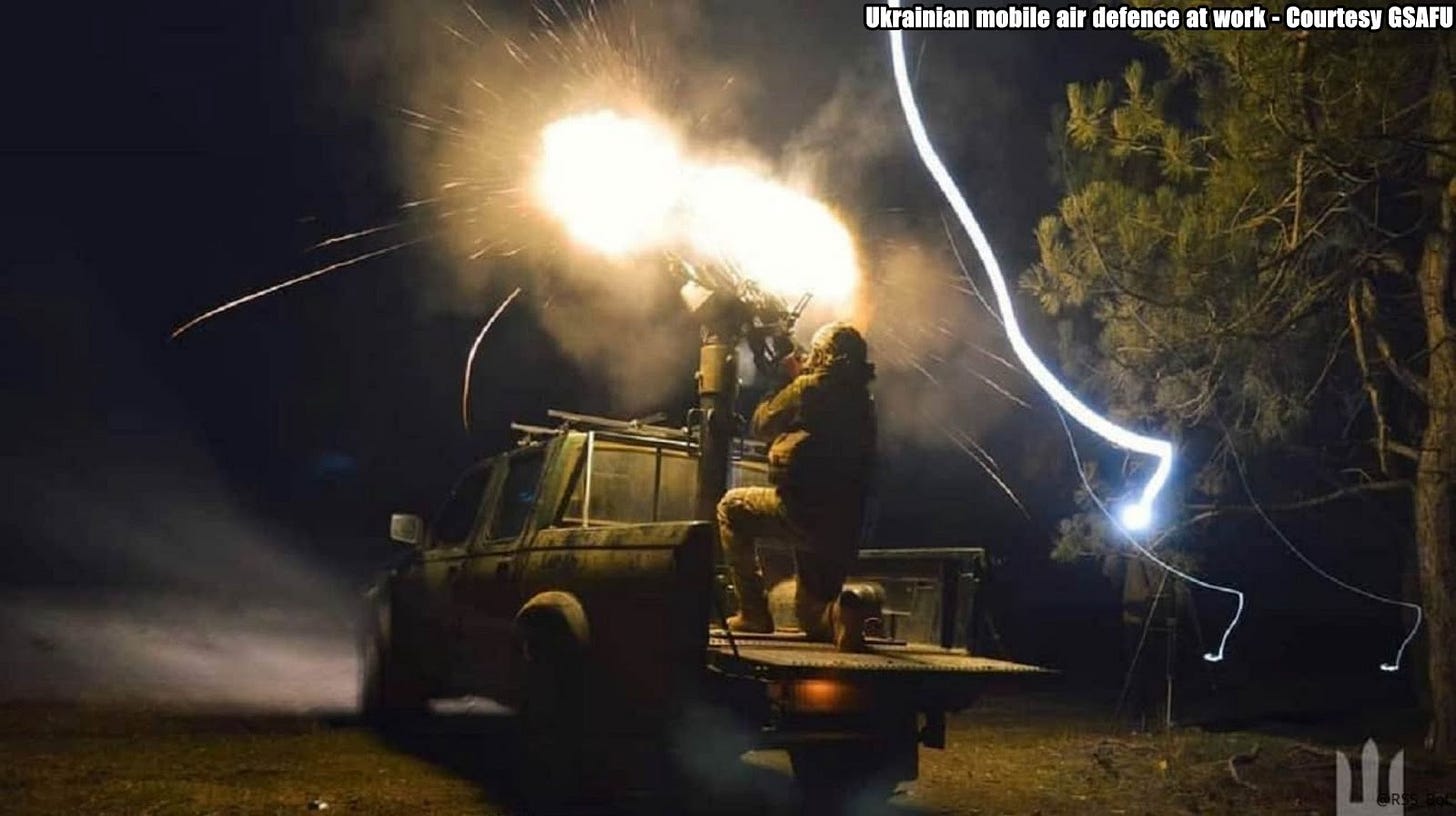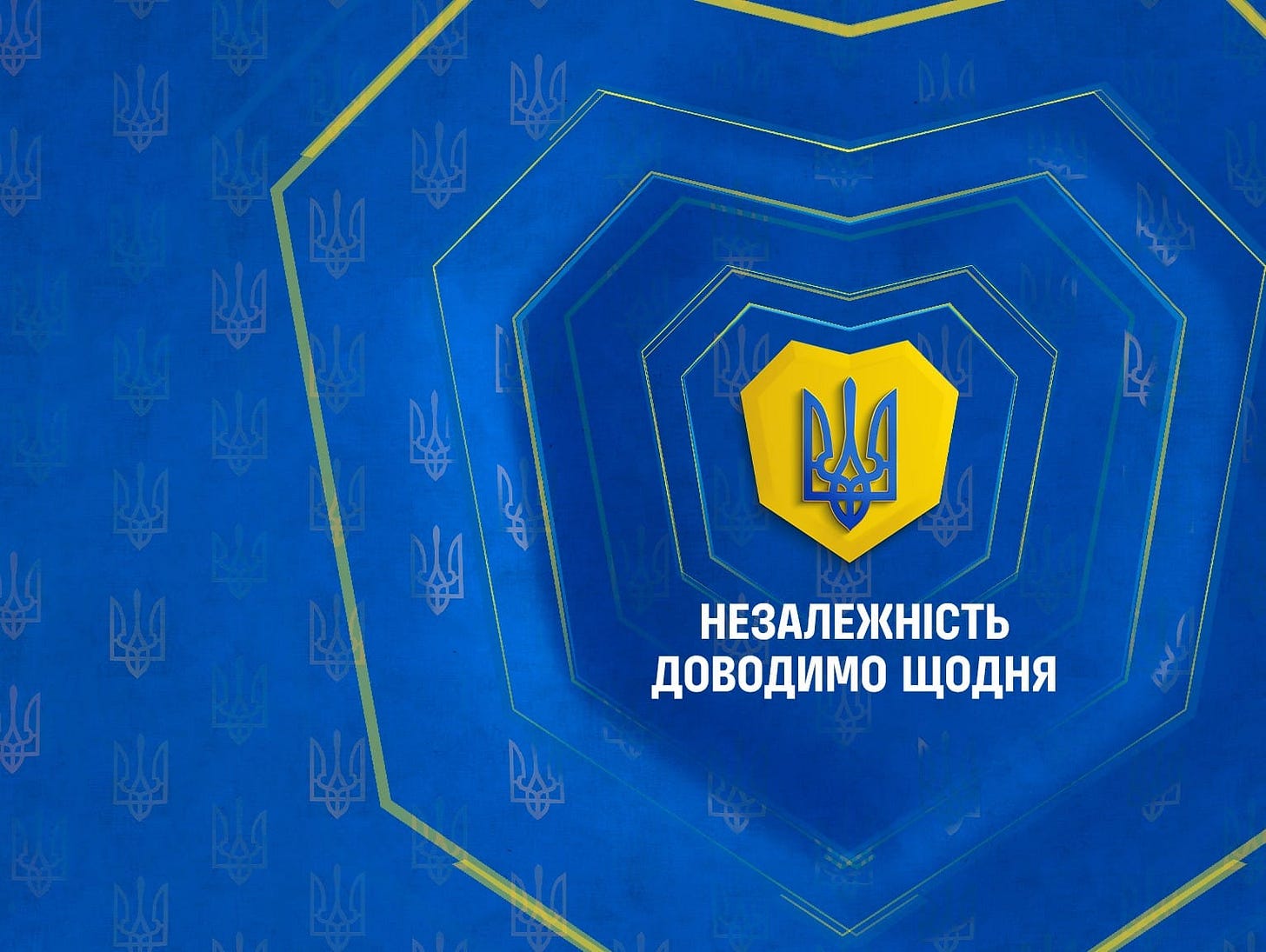Slava Ukraini! In early 2022 I began a Telegram channel aggregating news from a number of sources daily on the war in Ukraine. In June 2023 I began providing a daily draft for the Ukraine War Brief Podcast collecting news from over 70 sources daily, which formed the basis of the script. While the Podcast no longer exists I have continued to make this Brief available for my followers here on Substack for those who wish to keep up with the news from the war. A version of this Brief will also be made available on The People’s Media Substack for those who should choose to subscribe there.
All the latest news on the Russo-Ukraine War 6 days per week
ALONG THE CONTACT LINE
GSAFU Morning Report
The General Staff of the Armed Forces of Ukraine in its Operational Information update at 22:00 on Dec 2 stated that day 1014 of the full-scale invasion of the Russian Federation against Ukraine was about to begin.
During the past day, 193 combat engagements took place. Over the past 24 hours, the enemy carried out 1 missile strike, 25 air strikes,717 drone strikes and more than 4,000 artillery strikes across the positions of Ukrainian forces.
At the same time, Ukrainian soldiers continue to inflict losses in manpower and equipment on the occupying troops, exhausting the enemy along the entire front line and continue to disrupt the plans of Russian occupiers to advance deeper into the territory of Ukraine.
Air Force Daily Report
On the night of December 3, 2024 (from 10 p.m. on December 2) from the directions Primorsko-Akhtarsk, Kursk, Orel, Millerovo - Russian Federation. The enemy attacked with 28 attack UAVs of the "Shahed" type and drones of other types.
As of 09:00, units of anti-aircraft missile forces, EW and mobile fire groups of the Air Force and Defense Forces of Ukraine shot down 22 enemy UAVs in Kyiv, Chernihiv, Vinnytsia, Khmelnytskyi, Zhytomyr, Sumy, Odesa, Mykolaiv and Dnipropetrovsk regions.
1 drone was lost in location, 2 — left the controlled airspace in the direction of Belarus and the temporarily occupied territory. Several hits on critical infrastructure facilities in Ternopil region and Rivne region were recorded.
The Russian Border Incursion
The Institute for the Study of War (ISW), a US based think tank, in its Dec 2 Russian Offensive Campaign Assessment reported that fighting continued in the main Ukrainian Kursk Oblast salient on Dec 2, but neither Ukrainian nor Russian forces made confirmed advances.
Russian milbloggers claimed that Russian forces are advancing near Martynovka (northeast of Sudzha), although ISW has not yet observed confirmation of recent Russian advances in this area. Russian milbloggers also claimed that fighting continued southeast of Korenevo near Novoivanovka, Darino, and Nikolaevo-Darino and southeast of Sudzha near Pogrebki and Plekhovo.
Ukrainian military officials noted on Dec 1 and 2 that Russian forces assault Ukrainian positions in Kursk Oblast around the clock, sometimes with armored vehicles, and sometimes with lighter vehicles such as motorcycles and all-terrain vehicles (ATV), which Russian forces use to transport dismounted infantry to areas near the frontline.
A Russian insider source claimed on Dec 2 that Russian authorities have committed at least 10 million rubles ($94,000) to a project to turn the entire border into "one large, fortified area" following the failure of the Russian defensive lines in Kursk Oblast to deter the initial Ukrainian incursion into Kursk in August 2024.
A Russian insider source claimed on Dec 1 that a Ukrainian HIMARS strike hit a command post of the 83rd Airborne (VDV) Brigade in Kursk Oblast on November 30.
Elements of the Chechen "Aida" Spetsnaz group are reportedly operating northeast of Sudzha, and elements of the 11th VDV Brigade are reportedly operating throughout Kursk Oblast.
The Khortytsia operational-strategic group
(Responsible for the northeastern part of Ukraine. )
Kharkiv Sector: Over the last day Ukrainian Defense Forces repelled 6 Russian attacks in the area of Starytsia and Vovchansk. 2 engagements are ongoing.
Kupyansk Sector: Russian Forces carried out 7 offensive actions against Ukrainian defensive positions near Dvorichna, Petropavlivka, Kolisynivka, Lozova, Zelenyi Hai. 1 engagement is ongoing.
-
Lyman Sector: Russian Forces carried out 11 offensive actions against Ukrainian defensive positions near Kopanky, Cherneshchyna, Hrekivka, Terny and Yampolivka.
Siversk Sector: Russian Forces carried out 1 offensive action against Ukrainian defensive positions near Bilohorivka.
Kramatorsk Sector: Russian forces carried out 4 offensive actions against Ukrainian defences in the vicinity of Hryhorivka and Chasiv Yar.
Toretsk Sector: Over the last day Russian forces carried out 8 offensive actions with air support near Toretsk, Shcherbynivka and Nelipivka. 3 engagements are ongoing.
The Tavria operational-strategic group
(Responsible for the central-eastern and southeastern part of Ukraine.)
Pokrovsk Sector : Over the last day in this sector, Russian Forces carried out 40 offensive actions against Ukrainian defensive positions in the vicinity of Myrolyubivka, Promin, Krasnyi Yar, Chunyshyne, Novoukrainka Lysivka, Dachenske and Zhovte. 10 engagements are ongoing.
Kurakhove Sector: The highest intensity of combat over the last day was in this district, Russia conducted 67 offensive actions in the vicinity of Novodmytrivka, Zorya, Sontsivka, Stari Terny, Berestky, Kurakhove, Dalnje, Hannivka, Romanivka and Yelyzavetivka. 2 engagements are ongoing.
Vremivka Sector: Russian forces made 40 attempts to break through Ukrainian defences in the vicinity of Novodarivka, Novopil, Novosilka, Velyka Novosilka, Rozdolne and Kostiantynopolske. 1 engagement is ongoing.
Orikhiv Sector: In this sector, over the last day, there has been no significant change in the combat environment.
The Odesa operational-strategic group
(Responsible for Kherson, Qırım, (also known as Crimea) and the Black Sea.)
Prydniprovsk Sector: In this sector, over the last day, there has been no significant change in the combat environment. Russian forces made 2 unsuccessful attempts to dislodge Ukrainian units from their positions.
TEMPORARILY OCCUPIED TERRITORIES
Nothing major to report.
THE HOME FRONT
Journalists, anti-corruption groups denounce Ukraine’s attempt to increase punishment for state leaks
Parliament was scheduled to vote on Dec. 3 on a new law proposing up to eight years imprisonment for accessing or disseminating confidential state register information during martial law, a bill that Ukrainian media and human rights organizations have urged parliament to reject on free speech concerns. The Kyiv Independent reports.
However, parliamentary voting ended for the day without the bill coming up for vote.
“This is an attempt by the authorities to hide their dirty laundry from those who most often reveal it to the world, from investigative journalists,” Vitaliy Shabunin, head of the nonprofit Anti-Corruption Action Center's executive board, said about the bill.
“Moreover, not just to hide information, but to imprison those who help journalists – their sources – and curb investigative actions not only of journalists, but also of the editorial offices of large media outlets where their investigations are published,” Shabunin told the Kyiv Independent.
Recent investigations that have exposed corruption in Ukraine – such as reporting on illegal border-crossing schemes and the enrichment of officials in the Prosecutor’s Office – would have been illegal to publish under the new law had it been in place at the time, and could have carried harsh sentences for the journalists or their sources.
While the bill was on the parliamentary schedule for a Dec. 3 vote, a source in parliament told the Kyiv Independent that representatives of the European Union and G7 have appealed to parliament’s leadership, requesting a postponement of the vote in order to assess its compliance with EU law. It is unclear what the next plans for the bill are.
Parliament passed the bill in a first reading in January. At the time, many lawmakers opposed the bill, but it was allowed to continue to the second reading.
On Nov. 27, parliament’s Committee on Law Enforcement recommended adopting the draft law and sent it to parliament for a second and final reading. Proponents of the law say it is a matter of national security during martial law to protect sensitive information.
If the bill is passed, it will be sent to President Volodymyr Zelensky to be signed into law.
Current legislation carries a minor punishment for the illegal dissemination of nonpublic register information. The new changes to the criminal code would designate this activity a more severe type of violation and give law enforcement additional powers for carrying out investigations against sources and journalists suspected of violating the law, including secret wiretapping.
In an open letter published on the eve of the scheduled vote, journalists, media activists and human rights organizations urged parliament to reject the bill.
“This draft bill poses significant threats to freedom of speech, the work of journalists, and the protection of journalists' sources and corruption whistleblowers in Ukraine,” wrote the Mediarukh (Media Movement), an informal organization of Ukrainian media, journalists and public organizations, in an open letter.
The law does not contain any protections for those who disclose confidential information that is of public importance, and the proposed punishment is disproportionate, the letter says.
RUSSIAN WORLD
Putin-controlled aircraft deported Ukrainian children
Russian presidential aircraft and funds were used in a program that took children from occupied Ukrainian territories, stripped them of Ukrainian identity and placed them with Russian families, Reuters reports citing a report by Yale's School of Public Health.
The U.S. State Department-backed research, published on Tuesday, identified 314 Ukrainian children taken to Russia in the early months of the war in Ukraine as part of what it says was a systematic, Kremlin-funded program to "Russify" them.
In March 2023, the International Criminal Court issued arrest warrants for Russian President Vladimir Putin and his child rights' commissioner, Maria Lvova-Belova, for the alleged war crime of deportation of Ukrainian children.
At the time, Lvova-Belova said her commission acted on humanitarian grounds to protect children in an area where military action was taking place. Lvova-Belova's office did not immediately respond to a request for comment. The Kremlin said it could not respond to questions sent on Monday, citing a lack of time.
The new report, shared with Reuters, offers details of the alleged deportation programme and individuals involved, including what its lead researcher said were new links to Putin.
The researcher, Nathaniel Raymond, Executive Director of Yale's Humanitarian Research Lab, said he was scheduled to present the findings to the U.N. Security Council on Wednesday. The United States holds the rotating presidency of the 15-member body this month.
Raymond said the research offers evidence that would support additional charges by the ICC against Putin of "forcible transfer" of people from one national and ethnic group to another.
He further said the report proved "the deportation of Ukraine's children is part of a systematic, Kremlin-led program" to make them citizens of Russia.
Forcible transfer is a crime against humanity under international law. Because they must be widespread and systematic, crimes against humanity are generally considered more serious than the war crimes Putin is currently charged with for alleged deportation of Ukrainian children.
In response to Reuters questions, the ICC office of the prosecutor said the Yale report was useful "in our continued activities in this case." It said it could not provide further information about charges or actions that may arise from its investigative activities in Ukraine.
The Ukrainian president's office did not respond to requests for comment. Ukraine's prosecutor general's office said it had no immediate comment.
In response to the ICC charges last year, Lvova-Belova said Russia had not moved anyone against their will or that of their parents or legal guardians, whose consent was always sought unless they were missing.
She said children were placed with temporary legal guardians and were not given up for adoption.
Russia, which does not recognise the ICC, has said the court's warrants are meaningless. Court decisions could nonetheless limit travel by charged individuals because its 124 member states have an obligation to execute warrants.
Russian importers switch to smuggling due to sanctions against banks
Grumpy here - apologies for the poor quality of the translation in this article
A new portion of sanctions forced Russian importers to switch to more complex, sometimes dubious schemes for payments to China, which became the main supplier of goods to Russia. After more than 50 Russian banks blacklisted on November 21, including a significant portion of those that could still send direct payments to China, Chinese payment agents sharply intensified in Russia, foreign trade companies say. The Moscow Times writes.
«The bottom line is that the Chinese company offers you here to give her rubles under an agency agreement, and then she takes care of transferring money to the Chinese supplier », — tells the importer who switched to such a work scheme a month before the last sanctions, in the last week of October. According to him, the payment for the supply of clothes and shoes from Chinese factories reached the manufacturer in two days.
There are several options, says a consultant on foreign economic activity who has studied such schemes. According to him, the most reliable and «clean » for the Russian side, the options work according to the agent’s netting scheme with exporters who need to pay for goods from Russia. In this case, the Chinese side agrees on all issues related to money transfer channels, he continues.
Rates are average: if ordinary money dispatch agents take an average of 2.5-3% of the payment for non-sanction goods up to 10-15% for sanction codes and military goods, then the Chinese ask for about 3%.
Among these options, there are especially profitable ones that are already used by several large Russian sub-sanction banks, says another financial consultant. With the help of a Chinese agent with «great administrative capabilities » they offer Russian importers to pay with rubles for the supply of absolutely any goods from China — «at least the most sanctions » — with a commission within 1% to the official exchange rate of the renminbi to the ruble, and in fact use the Russian source for settlements The main drawback of this — scheme, it operates in certain provinces and banks of China — in those where buyers of Russian raw materials have accounts.
Some Chinese payment agents work according to the so-called — cargo scheme, that is, they pay in China with suppliers according to unconfirmed documented and often dubious chains from the point of view of the law, and import goods into Russia according to «gray » schemes or generally smuggling, TMT interlocutors say. It is impossible to control this, but after the November sanctions there is no other way. More and more importers, especially those purchasing dual-use goods or sanctions, are forced to use just such schemes — otherwise you will not buy the necessary goods in China and you will not bring them to Russia.
Chinese agents organizing such schemes are ready to take on part of the risks: for example, they offer insurance against loss of cargo or confiscation of it at customs — «total » for 15% of its value, says one of the importers. «But if you need to bring serious drone from China, say, it may turn out to be the most reliable option », — he concludes.
For those who purchase non-sanctionable goods in China, another pain — a sharp drop in the ruble exchange rate. Due to a depreciation of more than 10%, many Chinese trading platforms stopped shipments to Russia, and several importers told TMT that their Chinese suppliers had warned of a delay in supplies due to the depreciation of the ruble.
Russian drones flood Belarusian airspace during overnight attack on Ukraine
At least 21 Russian Shahed-type attack drones flew into Belarus, including three directly from Russian territory, New Voice reports citing the Belaruski Gayun monitoring group on Telegram on Dec. 3, detailing their routes during the overnight attack on Ukraine.
The drones entered Belarusian airspace from Ukraine and Russia’s Bryansk Oblast, flying toward the cities of Mazyr, Bragin, Gomel, and Rechitsa.
The Belarusian Air Force did not scramble fighter jets to intercept the attack.
INTERNATIONAL NEWS
First Signs Russia Is Evacuating Navy Ships From Syria
The Russian Navy's base at Tartus in Syria is crucial to its support of the Assad regime, and its ambitions on the world stage. The dramatic shift in the front lines in Syria now puts the base at risk. There are indications that Russia may be evacuating its naval vessels. Naval News reports.
The Russian Navy base at Tartus in Syria appears under imminent threat as the civil war turns against the Assad regime. As the front lines draw closer, Russia is already taking precautions. Russia currently has five naval ships and a submarine based in Tartus. These comprise of two Gorskhov class frigates, one Grigorovich class frigate, two axillaries and an Improved-Kilo class submarine.
One of these vessels, the auxiliary Yelnya, was noted departing Tartus on the morning of December 2 2024, with information suggesting that some or all of the other vessels also left. This unexpected move comes several days into a sudden change in the situation in Syria’s ongoing civil war. The Assad regime, of which Russia is a key ally, is now on the back foot. Opposition forces are rapidly advancing towards the capital.
Although unconfirmed, this ship movement is considered likely to be directly related to the situation on the ground. If so it is the first visible sign that Russia is moving valuable assets out of the country. Respected naval analyst Droxford Maritime noted on X and Bluesky that “there is a realistic possibility departure is related to the worsening situation in Syria.” Yelnya is a Project 160 Altay class oiler, which is a valuable asset and important to maintaining Russia’s force in the Mediterranean. Information suggests that the submarine, frigates and another auxiliary also sailed out of Tartus.
The naval base at Tartus on Syria’s Mediterranean coast is a strategic asset for Russia. The Russian Navy has maintained the naval base there since 1971 but it had fallen in use after the collapse of the Soviet Union. Since the start of the Syrian civil war in 2012 usage has increased again and it became Russia’s main overseas naval base. And since the start of the 2022 full-scale invasion of Ukraine it has taken on further significance. Russia boosted its military presence in the Tartus ahead of the invasion in order to counter and deter direct NATO involvement, particularly by aircraft carriers in the Mediterranean.
Tartus also acted as a staging base for major warships intending to join the fight in the Black Sea. As it transpired most of these, including two additional Slava class cruisers, were blocked by Türkiye from entering the Black Sea after the invasion started. They remained in the Mediterranean to offer support. Since then Russia has struggled to maintain that level of naval presence in the Mediterranean but the warships and submarine in Tartus remain key.
It now appears possible that the port will eventually be attacked or abandoned. Certainly it appears likely that Russian warships are leaving the once safe port. It is expected that the warships will sail from the Mediterranean to the Baltic. Possibly they will seek temporary safe harbour in Algeria or Libya on the way.
If Tartus remains in Russian control then it is likely to be used for any Russian heavy reinforcements. These will take weeks to arrive however so initial movements are more likely by air. Until February 2024 Russia maintained regular ship transits to the Black Sea, nicknamed the ‘Syrian Express’. These stopped however, likely because of the increased threat of Ukrainian surface drones (USVs) in the Black Sea. Now ships have to sail around Europe to the Baltic. If Russia is desperate to reinforce Syria, or evacuate heavy equipment, it may attempt the Black Sea route again. If so, it will expose itself to Ukraine’s surface drones.
The Russian spy ship Yantar, known for loitering near undersea cables, is also in the Mediterranean. It called briefly at Algiers on November 30 and has since gone dark on AIS (automated information system location broadcasts). How the situation in Syria affects it remains to be seen.
Russia to send mercenaries to Syria to reinforce its troops, Ukrainian intelligence claims.
Russia is sending private mercenaries to Syria to reinforce its troops, possibly its so-called Africa Corps, The Kyiv Independent reports citing the Ukrainian military intelligence agency (HUR).
“Moscow's leaders decided to send mercenaries from ‘private military companies’ to the Middle Eastern country to help them. The arrival of fighters – probably from the so-called ‘Africa Corps’ – is expected," the statement read.
Syrian rebels swept into the northwestern city of Aleppo on Nov. 30, launching a major attack that forced Russian-backed Syrian dictator Bashar al-Assad’s army to pull back.
"The Syrian government army and Russian military units are suffering significant losses, fleeing their positions, abandoning weapons and equipment, the retreat is chaotic," the Ukrainian intelligence agency claimed in its statement.
Russia's Africa Corps reportedly emerged in 2023 and consists of soldiers, officers, and experienced mercenaries, many of whom previously served in the Wagner Group. This group was very likely previously deployed in Syria, Libya, Burkina Faso, and Niger.
Russia's leadership has dismissed General Sergei Kisel, who commanded Moscow's military group in Syria, HUR said earlier. Russian forces have reportedly ramped up their bombing of rebel forces following the takeover of Aleppo.
U.S. Charges Russian Woman Over FSB Contacts
The United States has charged a Russian woman who engaged with anti-war opposition activists over false statements about her ties with Russia’s Federal Security Service (FSB), a U.S.-based non-profit of pro-democracy Russians said Monday. The Moscow Times reports.
New York resident Nomma Zarubina last month was accused of concealing her 2020 recruitment by an FSB agent under the code name “Alyssa,” according to the Russian America for Democracy in Russia (RADR).
“[Zarubina] aimed to build a network of U.S. contacts among journalists, military personnel, think tank researchers and Russia experts to influence their perspectives,” RADR said.
Zarubina, 34, faces up to five years in prison if found guilty of making false statements to law enforcement agencies, according to U.S.-based lawyer Igor Slabykh. He underscored that Zarubina is not accused of espionage or acting as a foreign agent. The United States has not commented on the case against Zarubina.
RADR said Zarubina’s case highlights that since 2016 she was mentored by Elena Branson, a dual Russian-American citizen charged in March 2022 with acting illegally as a Russian agent in the U.S..
RADR said Zarubina has engaged with its community organizers across various cities, attended discussion panels hosted by U.S. think tanks and posed for photos with notable Russian opposition figures since 2023.
RADR added that Zarubina recently began appearing as an expert at conferences held by the Free Nations of PostRussia Forum, a Poland-based platform that advocates for Russia’s decolonization and fragmentation into 41 independent states.
Russia last year labeled the Free Nations of PostRussia Forum an “undesirable organization,” and on Nov. 22 designated 172 of what it called its “subdivisions” as terrorist organizations.
Zarubina advocated for a “United States of Siberia” at the forum’s joint panel with the Jamestown Foundation in April, according to the Russian civil activist news outlet activatica.org.
Zarubina was released on $25,000 bail and banned from traveling outside New York. A judge scheduled a preliminary hearing in her case 30 days from Nov. 21, according to New York-based court reporter Matthew Lee.
Zarubina actively supported President Vladimir Putin and Russia’s 2014 annexation of Crimea on social media, according to an analysis by the investigative news website Agentstvo.
On Monday, Zarubina wrote on Facebook that media reports about her arrest amount to “rumors, opinions and blackmail.”
Zarubina told the Sibir.Realii news outlet that she had been summoned by the Russian special services in late 2020 but denied receiving any instructions from them. She then claimed to voluntarily report those and other contacts with Russians to the FBI in April 2021.
“I’ve since been in touch with the Americans around once every six months,” the U.S.-funded outlet quoted Zarubina as saying.
“I’ve known the people who arrested me for four years. I thought we had a very good relationship, I was kind of helping them,” she added.
Zarubina voiced fears that she may now become the target of Russia’s security services, which she said were unaware of her contacts with the FBI despite claiming to have her under surveillance in New York.
“This is no longer the level of false statements, but of treason. And it’s not safe for me to be in New York either.”
MILITARY & TECH
Russia has increased Shahed production but Ukraine has improved both its methods of downing them and its EW protection.
The Institute for the Study of War (ISW), a US based think tank, in its Dec 2 Russian Offensive Campaign Assessment reported that Russia's increased domestic production of Shahed-type drones has allowed Russia to increase the number of drones it is using in strike packages launched at Ukraine, but Ukrainian electronic warfare (EW) innovations are enabling Ukrainian forces to more effectively respond to Russian strike packages. Ukrainian military expert Petro Chernyk told Ukrainian military-focused outlet ArmyInform on Dec 2 that Russia has increased the productions of Shahed drone airframes while continuing to rely on Iranian or Chinese imports for other drone components.
Chernyk's statements accord with ISW's October 2024 assessment that Russia is leveraging its domestication of Shahed-type drone production to increase the number of Shahed-type drones it launches at Ukraine.
This dynamic is reflected in the composition of the strike packages that Russia launched at Ukraine between October and Nov 2024, as it has become more common for Russian forces to launch between 80 to 100 (or more) Shahed and decoy drones as part of their larger strike packages. Russian forces launched 110 Shahed drones and other unspecified drones, likely decoys, at Ukraine on the night of Dec 1 to 2, for example. Russian forces most likely use large numbers of Shahed-type drones and decoy drones to detect and overwhelm Ukrainian air defense and mobile fire groups; Russian forces most frequently launch Shaheds alongside more limited numbers of cruise and ballistic missiles.
Ukraine appears to be responding to this influx of Shahed drones in kind, however. The number of Shahed or decoy drones that are reportedly "lost" (do not reach their intended targets) due to Ukrainian electronic warfare (EW) interference increased significantly over the course of Oct and Nov 2024. Russia launched 105 Shahed-type drones at Ukraine on Oct 2, 78 of which Ukrainian forces directly shot down and 23 of which the Ukrainian Air Force reported were "lost" due to EW interference (22 percent). In contrast, Russian forces launched 110 Shaheds and decoys at Ukraine on the night of Dec 1 to 2, 50 of which were "lost" due to Ukrainian EW interference (45 percent), and 52 of which Ukrainian forces shot down.
Chernyk noted the high Ukrainian shoot-down rate and also emphasized that Ukraine has improved its EW capabilities to the extent where Ukrainian forces can either "ground" the Shaheds, cause them to get "lost," or cause them to deviate their paths and fly into Russian or Belarusian airspace.
Ukrainian EW interference is significantly impacting the performance of these Russian strike packages and notably adding an increased burden on the joint Russian-Belarusian air defense umbrella. Independent Belarusian monitoring group Hajun Project reported on Nov 25 that 38 Russian Shahed drones entered Belarusian airspace on Nov 24 and 25 – a record number of Russian drones violating Belarusian airspace. Belarus scrambled jets to respond to the airspace violation—suggesting that Belarus was unprepared to receive errant Russian drones and that Russia had not anticipated the impacts of Ukrainian interference or communicated them to Belarus in advance.
That’s it for today’s Brief folks if you would like to keep up with events in Ukraine daily please consider subscribing.
Feel free to share this update with your friends. Heroyam Slava!







